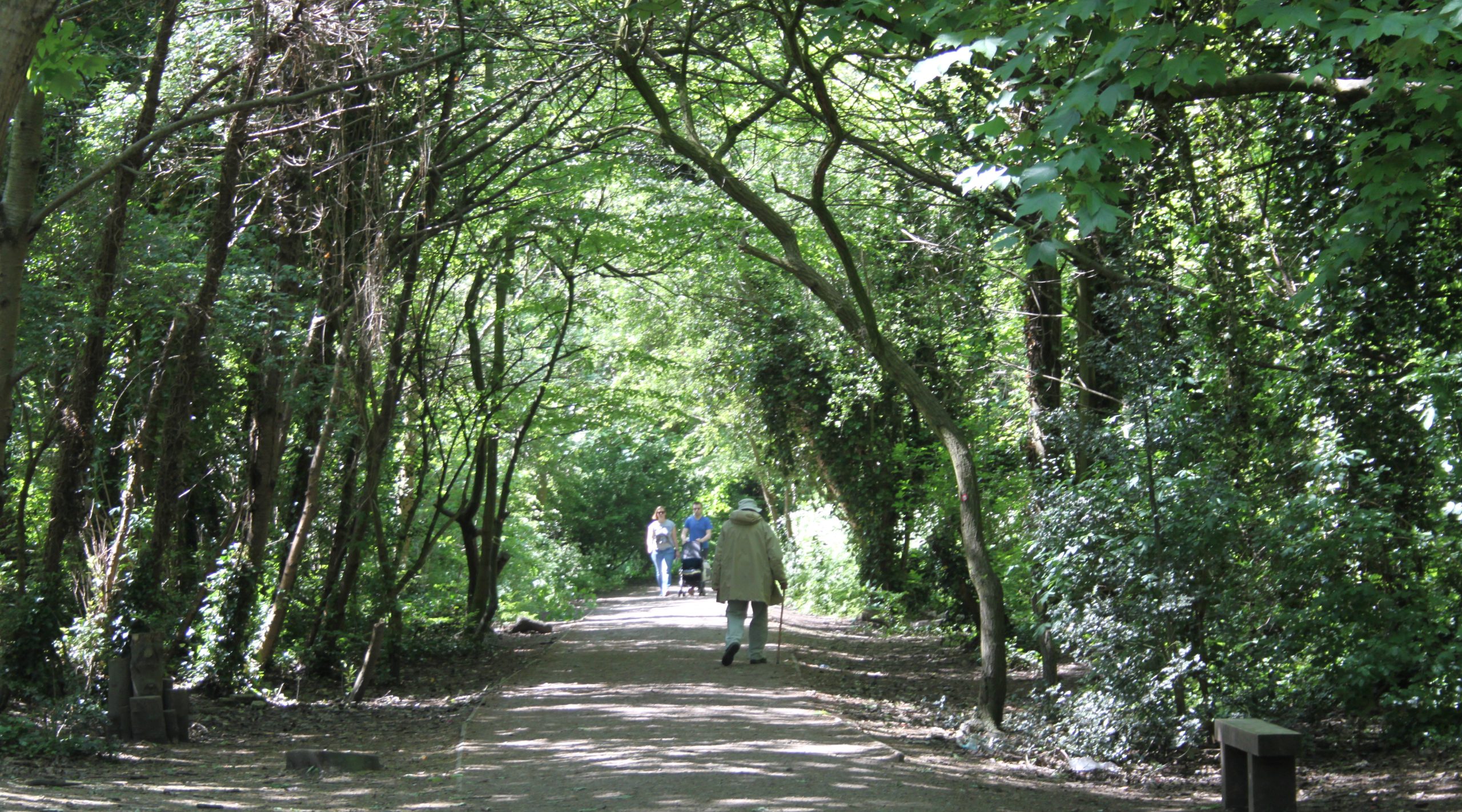As you stroll along the Parkland Walk you will notice that there are only a few very mature trees and that many of these grow close to the boundary fences, well away from the old trackbed. This is the result of policies by railway companies to keep the embankments and cuttings clear in order to prevent fires caused by passing steam trains.
In 1954 the last passenger train ran and in 1970 the line was finally closed after dwindling use by freight traffic and carriage haulage. It’s to be presumed that management of the slopes was also on the decline during that same period, with the result that trees would be able to colonise freely. In consequence a large percentage of the trees have established in quite recent times.
When looked at as a whole, the vegetation pattern of the Walk now forms a young, deciduous woodland. Previously there was a much wider range of habitats. In some places conservationists now term sections of the woodland as a ‘closed canopy’ meaning the woodland floor is denied light.

Trees to look out for:
For a really detailed description of these trees visit The Woodland Trust website
| Alder, common; black | Alnus glutinosa |
| Apple, crab | Malus sylvestris |
| Ash | Fraxinus excelsior |
| Aspen | Populus tremula |
| Birch, hairy; white, downy | Betula alba |
| Birch, silver; warty | Betula pendula |
| Butterfly bush* | Buddliea davidii |
| Cherry, wild; Gean | Prunus avium |
| Chestnut, horse* | Aesculus hippocastanum |
| Elder | Sambucus niger |
| Elm, common; field, English | Ulmus procera |
| Elm, wych | Ulmus glabra |
| Fig* | Ficus |
| Hawthorn, common | Crataegus monogyna |
| Hawthorn, Midland | Crataegus laevigata |
| Holly | Ilex aquifolium |
| Hornbeam | Carpinus betulus |
| Laburnum* | Laburnum anagyroides |
| Lime, common* | Tilia x europaea |
| Lime, small-leaved | Tilia cordata |
| Maple, field | Acer compestra |
| Maple, Norway | Acer platanoides |
| Oak, holm; evergreen | Quercus ilex |
| Oak, pendunculate; English | Quercus robur |
| Oak, sessile; durmast | Quercus petraea |
| Oak, Turkey* | Quercus cerris |
| Pine, Scots | Pinus sylvestris |
| Poplar, grey | Populus canescens |
| Poplar, ‘railway’ | Populus x euroamericana |
| Poplar, hybrid; black* | Populus nigra |
| Poplar, Lombardy* | Populus, ‘Italica’ |
| Poplar, white | Populus alba |
| Robinia; false acasia, locust | Robinea psuedoacacia |
| Rowan, mountain ash | Sorbus aucuparia |
| Stag’s horn sumach* | Rhus typhina |
| Sycamore* | Acer pseudoplantus |
| Walnut | Juglans regia |
| Willow, goat | Salix caprea |
| Willow, grey | Salix cinerea |
| Willow, white | Salix alba |
| Yew | Taxus baccata |
*These trees are not native to the British Isles even though some are extremely common and familiar.
Tree management
The management of trees is an important part of the overall management plan, and the aims are threefold;
- To maintain and ensure future continuity of the Walk’s open woodland character.
- To encourage a wide diversity of native tree species.
- To favour the growth of those species which support the most diverse communities of associated wildlife.
To achieve these aims it is necessary to carry out the following practical activities:
Thinning – to remove ‘weed trees’ like sycamore, which would otherwise dominate areas and prevent the growth of favoured species, also to allow light to reach the woodland floor and stimulate the growth of plants other than trees.
Mowing – to ensure that the grassy embankments are not over colonised by trees and the Walk turned into continuous woodland.
Limited planting – for the introduction of new native species, to increase the number of favoured species and to ensure future generations of mature trees.
Coppicing – Coppicing is the practice of cutting trees and shrubs to ground level, promoting vigorous re-growth and a sustainable supply of timber for future generations. Cutting an established tree down to it’s base instigates the fresh growth of many smaller shoots, which quickly grow upwards towards the sky. After 8-15 years, these are then harvested, restarting the cycle once more. This can help to prevent the manifestation of dead or diseased wood in the tree, by renewing constant fresh growth and the removal of old wood, allowing the tree to live for a lot longer than if it were left un-coppiced. Coppicing also promotes periods of increased light stimulating ground flora.
Trees adjacent to your property in Haringey
The following guidance is given regarding Haringey Council’s policy on tree reduction where a tree is adjacent to your property:
Tree works in Parks and Nature Conservation sites are only undertaken when in accordance with the sites management plan or to mitigate an actionable nuisance (tree branches are touching a building) or a potential risk to site users. We do not carry out pruning works to increase the amount of sunlight reaching properties or gardens.
However, in the past, we have permitted residents to carry out pruning works to trees on the Parkland Walk that are immediately adjacent to their gardens on the condition that any works are undertaken by a qualified and experienced tree surgery company, and that we are given a copy of the job specification (including site plan) for prior approval.Alex Fraser
Arboricultural and Allotments Manager
Haringey Council
4th Floor, River Park House,
225 High Road, London, N22 8HQ
